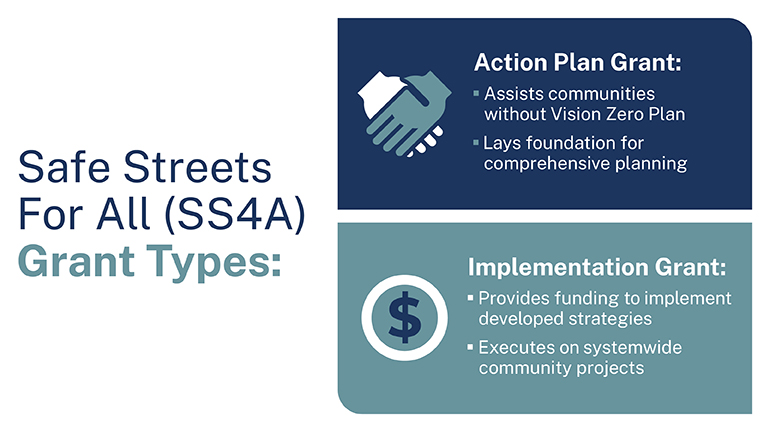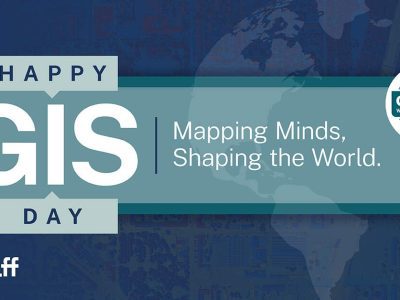Funding Vision Zero Plans: How SS4A Grant Program Can Help Your Project in 2023
Safe streets shouldn’t be optional. They should provide efficient accessibility and a safe environment for people to enjoy their lives and surroundings. Projects aimed at improving street safety require proper funding to come to life.
The new Safe Streets and Roads for All (SS4A) grant program was established through the Bipartisan Infrastructure Law (BIL) in November 2021. A historic $800 million was awarded to more than 500 projects in Fiscal Year 2022 through the SS4A grant program. This discretionary grant program supports local initiatives that are also referred to as “Vision Zero” or “Toward Zero Deaths” initiatives.
Vision Zero utilizes the Safe Systems Approach, aiming to prevent death and serious injury on roads and streets. The goal of Vision Zero is to increase safety in streets and communities by achieving zero fatalities and serious injuries. It seeks to fundamentally change how communities view safety. Although Vision Zero can be categorized as its own initiative, did you know the SS4A grant program funds these initiatives?
Many organizations and individuals are unaware of how SS4A can provide roadway funding. The SS4A program supports the Department of Transportation’s (DOT) National Roadway Safety Strategy by creating an opportunity for communities to obtain funding to invest in more meaningful Vision Zero and Safe System strategies.
Roadway design plays a critical role in improving community livability as it increases engagement and improves the overall quality of life for those within a community. Streets are more than just a thoroughfare; they should serve as a safe space for people to gather, stroll, shop and explore activities that make life enjoyable. Keep reading to see how the SS4A program makes safer streets possible for your community.
Overview:
- Two SS4A Grant Types
- How Can Communities Prepare for SS4A Grants?
- Components of a Competitive Project
- Helpful Funding Resources
Two SS4A Grant Types
Through the SS4A program, the DOT awards two different types of grants. One is for planning and demonstration projects, and the other is for implementation projects.
Planning and demonstration grants (formally known as action plan grants) assist communities that do not currently have an adopted comprehensive roadway safety plan (Vision Zero Plan) in place. These plans lay the foundation for a comprehensive set of actions. There are three different categories to apply for:
1. Develop a Vision Zero Action Plan or similar safety plan.
This is fundamental and the key to success. A plan should include elements such as community building and political buy-in through robust engagement with various public and private stakeholders. Data-driven decision-making helps to develop a High-Injury Network, prioritizing projects that address underserved populations. A plan should also include a method for measuring progress. Access a detailed SS4A Action Plan Components list or review the NOFO for further information.
2. Conduct supplemental safety planning to enhance an Action Plan.
Complementary planning activities that support or enhance an existing Action Plan may include sub-plans focused on speed management, vulnerable road users, the Americans with Disabilities Act of 1990 (ADA) transition plan, health equity and lighting management plans.
3. Carry out demonstration activities to inform the development of or an update to an Action Plan.
The demonstration activities inform an Action Plan by testing proposed project and strategy approaches to determine their potential benefits and future scope. These activities could include feasibility studies, various Manual on Uniform Traffic Control Devices (MUTCD), engineering studies that further the safety of the MUTCD, pilot programs for behavioral or operational activities that include at least one element of the Safe System Approach, or pilot programs that demonstrate safety benefits of technologies not yet adopted in the community.
Implementation grants provide funding for communities to implement strategies and projects identified in the Vision Zero Plan. When considering projects for implementation, think of a systemwide project that produces community-wide changes. Projects and strategies that could be included are roadway corridor transformation, street design changes, low-cost safety treatments, data collection and more (DOT, 2023). For more examples, visit the DOT’s SS4A Grant Program website.
How Can Communities Prepare for SS4A Grants?
If you are interested in applying for funds to develop an Action Plan:
-
- Identify key partners and stakeholders.
- Consider how to engage community members, specifically those historically underrepresented in transportation decision-making.
- Explore Complete Streets policies that prioritize the safety of all users in transportation network planning, design, construction and operations, especially on roadways where adjacent land use could be served via multi-modal design.
For applicants seeking funding for projects and strategies already identified in an established Action Plan:
-
- Certify that you have an existing plan that qualifies as an Action Plan by completing the Self-Certification Eligibility Worksheet.
- Consider which specific activities and projects would address the most pressing roadway safety issues.
Consider the extent to which additional planning and design are needed for potential projects. You must also assess the applicability of laws such as the National Environmental Protection Act (NEPA) or the National Historic Preservation Act (NHPA).
Components of a Competitive Project
A competitive project will consist of the following components:
-
- Reduces or eliminates transportation-related fatalities and serious injuries involving various road users (pedestrians, bicyclists, motorists and commercial operators)
- Demonstrates robust engagement with a variety of public and private stakeholders
- Incorporates evidence-based strategies and projects, and adopts innovative technologies or strategies to promote safety
- Utilizes low-cost, high-impact strategies that can improve safety over a wider geographical area
- Ensures equitable investment in the safety needs of underserved communities in preventing transportation-related fatalities and injuries in both urban and rural communities
- Aligns with the Department’s mission and strategic goals such as safety, climate change and sustainability, equity and Justice40, workforce development, job quality and wealth creation
- Demonstrates the ability of the project to complete the full scope of work in the application within five years of the grant being executed
View the full list of awards for the SS4A grant program in 2022. The next funding opportunity of $1.1 billion is open now, with a due date of July 10, 2023. The DOT anticipates announcing the recipients of the Planning and Demonstration Grants in October 2023 and the Implementation Grants in December 2023.
Helpful Funding Resources:
-
- Explore more details about the SS4A Grant Program, including information for interested applicants and stakeholders.
- Read here for more information on resources for interested stakeholders.
- Learn more about the Department of Transportation’s National Roadway Safety Strategy (including the Safe Systems Approach).
Need help jumping into funding opportunities? Halff has grant and funding experts ready to assist and answer your questions. Please contact our Funding Resources team to speak with Funding Resources Program Manager Elizabeth Range-Pendell (eRangePendell@Halff.com) or Florida Funding Resources Manager Lisa King (lKing@halff.com).







